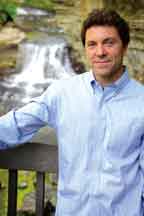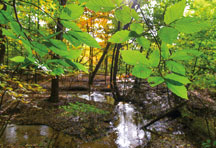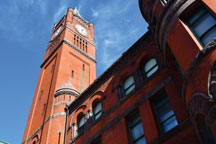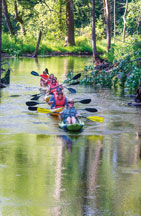From the Director
PROTECTING LAND PARCEL BY PARCEL
HELPING HOOSIERS REMEMBER THEIR PAST
SHARING THE LOVE
From the Director
 SHARING A LOVE OF THE OUTDOORS
SHARING A LOVE OF THE OUTDOORS
You will find interpretive naturalists at all of our state parks and many other DNR properties.
The subject of the article starting on page 30, these DNR staff members are the friendly fountains of information who enhance your visits by sharing what they know. Mostly, they focus on the natural, cultural, recreational, and historical features of that particular property, but they also know a ton about conservation and our surroundings in general.
I think of them as educators. Although our interpretive naturalists conduct some programs indoors, usually in our nature centers, their mission is all about the outdoors. At Chain O'Lakes State Park, where the 1915 Stanley Schoolhouse is used in some programs, the teaching theme can be obvious. At other places, that message may be more subtle.
When I spend time with one of our interpretive naturalists, I'm like a student all over again. I find the outdoors to be the perfect place for a virtual classroom, and I always learn something new about a subject I love when "school" is in session.
Passing on such lessons is important because participation in outdoor recreation is dropping, particularly among young people. Because studies show a strong tie between recreating outdoors and supporting conservation, getting more people outside means going beyond sharing the fun. Getting more people outdoors also requires teaching responsible stewardship and encouraging them to share what they learn and love.
Just like our interpretive naturalists do.
PROTECTING LAND PARCEL BY PARCEL
 Trusts add to various conservation areas
Trusts add to various conservation areas
By Marty Benson, OI Staff
What do the words "pig dig" mean to you?
Perhaps a snippet from a nursery rhyme? A childish attempt at verse? A hole constructed by a porcine critter?
Could be. But in this case, those words are the nickname dubbed by insiders to arguably the most significant recent acquisition of the past year using funds from the Benjamin Harrison Conservation Trust (BHCT).
At first, the official name of the tract, Megenity Peccary Cave, might not provide a clue as to why anyone might call it pig dig. The answer to the pig portion lies in the term peccary. In today's world, a peccary, aka a javelina or skunk pig, is a medium-size pig-like hoofed mammal. They are found throughout Central and South America, and in southwestern North America - not in Indiana.
But a flat-headed peccary once roamed what would become the Hoosier state 12,000 to 130,000 years ago, during the last ice age. So, "pig" fits.
And the dig part? Well, you’ve probably figured that out by now. Dig is what paleontologists do and informally call the sites where they do it. Indiana State Museum personnel have been working in this Crawford County cave near Patoka Lake since 1987, with the approval of the owners. They discovered that a deep pit in the back of the cave was the permanent grave of many ice age animals, including 600 flat-headed peccaries - the largest such collection in North America.
So, "pig dig."
Cutline: American beech tree leaves frame Reynolds Creek at Elizabeth McCloskey Reynolds Creek Ravines Nature Preserve in northwest Indiana.
To read the rest of this article subscribe to Outdoor Indiana or pick up a copy at most Barnes and Noble bookstores, and state park inns. To subscribe, click here or call (317) 233-3046.
HELPING HOOSIERS REMEMBER THEIR PAST
 DNR division has done so for 50 years and counting
DNR division has done so for 50 years and counting
By Scott Roberts, OI staff
A bus stops at Indianapolis Union Station. It's full of people eager to get to their destinations. They walk fast at first, their heads down, looking for the quickest way out.
One glances up. And stops in his tracks.
He pulls out his smartphone and begins to take photos - the grand arches, the ornate stonework, and the rose window.
Soon, others do the same. Some just stand there in wonder, not expecting this beauty so soon. A murmur of conversation begins about this place. How did it get here? How was this built?
Paul Diebold, assistant director of preservation services for DNR's Division of Historic Preservation & Archaeology, has witnessed such scenes many times.
"When people come to Indianapolis, they are not expecting to see that, and they're blown away enough to take photos and videos of it," Diebold said of Union Station. "When you see buildings like these, it lets you know, 'I'm in Indianapolis right now.' "
Experiences like that are why DHPA works to preserve historic places. Architecture can inspire, especially the grand spectacle that is Union Station, but historic preservation is about more.
Cutline: The 1888 Union Railroad Station clock tower in Indianapolis last fall. More than 200 daily trains once passed through the station. (John Maxwell photo)
To read the rest of this article subscribe to Outdoor Indiana or pick up a copy at most Barnes and Noble bookstores, and state park inns. To subscribe, click here or call (317) 233-3046.
SHARING THE LOVE
 Interpretive naturalists spread the lore about DNR's special places
Interpretive naturalists spread the lore about DNR's special places
By Scott Roberts, OI staff
Love of nature and fondness for comfortable footwear.
These are two of interpretive naturalists’ favorite things.
Have been for a long time.
Lucy Pitschler, who is recognized as the pioneer of Indiana's group of experts whose job it is to explain the wonders of DNR's destinations to its guests, set the tone. She was a member of the Indiana Nature Study Club in 1923 and spent three weeks of vacation at McCormick's Creek State Park, becoming enamored with its cliffs, caves and creeks.
She became known as "the little lady in tennis shoes" after she began taking groups to the park to share what she enjoyed, eschewing less comfortable shoes of that time for footwear that would get her across the rough terrain. Her guided tours, which usually included a lot of children, caught on.
Three years later, McCormick's Creek covered her expenses and lodging so she could work from June 1 to Sept. 1 on site. Previously, she was a volunteer. With that compensation, Pitschler brought professional nature guiding, a service already offered in some state and national parks, to Indiana.
Col. Richard Lieber, director of the Indiana Department of Conservation, precursor to today's DNR, took notice in 1927, asking Pitschler to launch similar efforts at Turkey Run and Clifty Falls state parks.
The interpretive naturalist program has steadily grown to having 22 full-time staff working on 32 State Park properties along with five regular part-time and 80 seasonal employees. The team is guided by a chief of interpretation. Deam Lake and Starve Hollow state recreation areas, which are managed by the Division of Forestry, employ part-timers in a similar role.
The job title has morphed from nature guide to naturalist to interpretive naturalist as the scope of the profession has changed over the last century, but the focus has not.
Cutline: Kaitlyn Sproles leads a group of kayakers on an adventure at Chain O’Lakes State Park, which boasts nine connected lakes. Photo by Frank Oliver.
To read the rest of this article subscribe to Outdoor Indiana or pick up a copy at most Barnes and Noble bookstores, and state park inns. To subscribe, click here or call (317) 233-3046.
